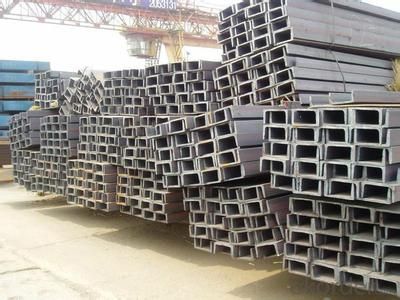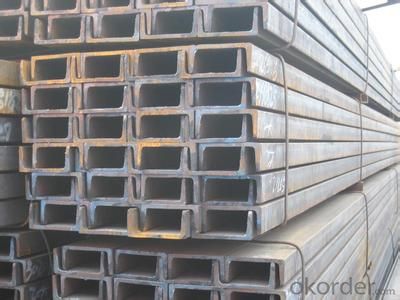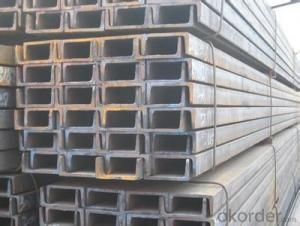Prime Hot Rolled Channel Steel from China GI Channel Steel Channel
- Loading Port:
- Tianjin
- Payment Terms:
- TT OR LC
- Min Order Qty:
- 2000 PCS
- Supply Capability:
- 40000 PCS/month
OKorder Service Pledge
OKorder Financial Service
You Might Also Like
Prime Hot Rolled Channel Steel from China GI Channel Steel Channel Details
Standard: | AISI,ASTM,BS, DIN,GB,JIS | Dimensions: | 50*37*4.5mm-400*104*14.5mm | Grade: | Carbon steel |
Place of Origin: | Shanghai China (Mainland) | Brand Name: | Baosteel Masteel Ansteel Shousteel Shasteel | Model Number: | Q195,Q215,Q235, A36,SS400,SS540 |
Shape: | GI Channel | Application: | Construction;Vehicle manufacturing; Industrial structure etc. | Perforated Or Not: | Not Perforated |
manufacturing technique: | Hotrolled Can be processed again repeatedly | sulphur content: | Q235B/S(0.02)% S355JR/S(0.013)% | Phosphorus Content: | Q235B/P(0.03)% S355JR/P(0.012)% |
silicon content: | Q235B/Si(≥0.19)% S355JR/Si(≥0.002)% | manganese content: | Q235B/Mn(0.45)% S355JR/Mn(1.35)% | Carbon Content: | Q235B/C(0.12-0.20)% Q3S355JR/C(0.12-0.20)% |
elongation: | Q235B/26min S355JR/26min | strength of extension: | Q235B/420MPa S355JR/485MPa | Yield Strength: | Q235B/235-280MPa S355JR/335-360MPa |
breed classify: | semi-killed steel or killed steel |
Packaging & Delivery
| Packaging Detail: | Prime hot rolled gi channel from china 1. It can be packed by container or bulk vessel. 2. 20ft container can load 25 tons, 40ft container can load 26 tons. 3.Standard export seaworthy package, it use wire rod with bundle according product's size. 4.Or we can make it as your requirement. |
| Delivery Detail: | 15 working days after received the deposit or L/C. |
Prime Hot Rolled Channel Steel from China GI Channel Steel Channel Specifications
Prime hot rolled gi channel
Competitive price
Fast delivery time
Customized length
Prime Hot Rolled Channel Steel from China GI Channel Steel Channel Pictures


- Q:Are steel channels suitable for use in electrical applications?
- Yes, steel channels are suitable for use in electrical applications. Steel channels are often used in electrical applications due to their strength, durability, and conductivity. They provide a secure and stable mounting solution for electrical components and wiring. Steel channels also offer excellent protection against physical damage, moisture, and other environmental factors. Additionally, steel channels can be easily customized and adjusted to accommodate various electrical configurations. Overall, steel channels are a reliable choice for electrical applications as they ensure the safety and efficiency of electrical systems.
- Q:Do steel channels require any special maintenance?
- Steel channels do not require any special maintenance. However, regular maintenance is necessary to ensure their longevity and performance. This maintenance typically includes cleaning and inspecting the channels for any signs of damage or corrosion. If any issues are identified, they should be promptly addressed to prevent further deterioration. Additionally, lubricating the channels regularly can help reduce friction and wear, ensuring smooth operation. By following these maintenance practices, steel channels can remain in optimal condition and provide reliable support and structural integrity.
- Q:How do steel channels compare to other types of steel profiles?
- Steel channels have distinct advantages compared to other types of steel profiles. They are known for their high strength and durability, making them suitable for structural applications. Additionally, steel channels offer excellent load-bearing capabilities and can efficiently distribute weight, making them ideal for construction and engineering projects. Their unique shape provides versatility and ease of installation, ensuring stability in various applications. Overall, steel channels are a preferred choice due to their superior strength, versatility, and ability to withstand heavy loads.
- Q:Can steel channels be used for shelving systems?
- Yes, steel channels can be used for shelving systems. Steel channels are strong and durable, making them suitable for supporting heavy loads. They can be easily attached to walls or other structures to create a stable and sturdy shelving system. Additionally, steel channels come in various sizes and lengths, allowing for customization to fit different storage needs. Overall, steel channels are a popular choice for shelving systems in warehouses, garages, and other industrial settings due to their strength and versatility.
- Q:How do steel channels contribute to the overall safety of a structure during floods?
- Several ways exist in which steel channels contribute to the overall safety of a structure during floods. Primarily, they offer structural support and reinforcement to the building, enhancing its resistance to the forces and pressure exerted by floodwaters. These channels are engineered to endure high loads and distribute weight evenly, thereby ensuring stability and integrity even in extreme flood conditions. In addition, steel channels can be strategically positioned in flood-prone areas to divert the flow of water away from critical parts of the building. By creating barriers or channels, they assist in controlling and managing water flow, averting its entry into vulnerable spaces or damage to the foundation. This redirection of water minimizes the risk of structural failure or collapse during floods. Moreover, steel channels possess high resistance to corrosion, a crucial characteristic in areas prone to flooding where frequent water exposure occurs. Utilizing corrosion-resistant steel channels significantly reduces the risk of deterioration and weakening of the structure due to prolonged water exposure. Furthermore, steel channels can be utilized to fabricate flood-resistant doors and barriers. These doors are designed to withstand the water pressure and prevent its entry into the building. This proves particularly vital in critical areas such as basements or lower levels, where water infiltration can cause extensive damage to utilities or compromise the overall stability of the structure. In summary, steel channels enhance the overall safety of a structure during floods by providing structural support, redirecting water flow, resisting corrosion, and creating flood-resistant barriers. Incorporating these features into the design and construction of a building significantly mitigates the risk of damage and destruction during floods, ensuring the safety of occupants and preserving the structure's integrity.
- Q:Larry Midas in seeking to inform how to model such as: steel, double steel, double channel
- Sorry, the attachment uploaded by the respondent is invalid
- Q:What are the different surface treatments available for steel channels?
- There are several surface treatments available for steel channels, each designed to enhance the appearance and performance of the material. Some of the most common surface treatments for steel channels include: 1. Galvanization: This process involves coating the steel channel with a layer of zinc, which provides protection against corrosion. Galvanized steel channels are highly durable and can withstand exposure to harsh weather conditions, making them ideal for outdoor applications. 2. Powder coating: Powder coating involves applying a dry powder to the surface of the steel channel, which is then heated and cured to create a smooth, durable finish. This treatment provides excellent protection against corrosion, impact, and scratches, while also offering a wide range of color options. 3. Painting: Painting is a cost-effective surface treatment option that involves applying a layer of paint to the steel channel. This treatment not only enhances the appearance of the material but also provides protection against corrosion and environmental factors. 4. Anodizing: Anodizing is commonly used for aluminum channels, but it can also be applied to steel channels. This process creates a layer of oxide on the surface of the steel, which improves corrosion resistance and provides an aesthetically appealing finish. 5. Epoxy coating: Epoxy coating involves applying a layer of epoxy resin to the steel channel, which provides exceptional corrosion resistance and chemical resistance. This treatment is often used in industrial settings where the channels are exposed to harsh chemicals or extreme conditions. 6. Hot-dip coating: Hot-dip coating is similar to galvanization but involves immersing the steel channel in a molten zinc bath. This process creates a thick layer of zinc coating, offering enhanced corrosion protection and durability. It is important to consider the specific requirements and application of the steel channel when selecting a surface treatment. Each treatment has its own advantages and limitations, and choosing the right one will ensure the longevity and performance of the steel channel.
- Q:How do steel channels contribute to the sustainability of a building?
- There are several ways in which steel channels contribute to the sustainability of a building. To begin with, steel channels are produced using recycled steel. This reduces the demand for new raw materials and minimizes the environmental impact of mining and extraction processes. By utilizing recycled steel, the carbon footprint of a building is significantly reduced compared to the use of traditional construction materials. In addition, steel channels have a long lifespan and are highly durable. They are resistant to corrosion, fire, and pests, requiring minimal maintenance over the lifetime of a building. This durability reduces the need for frequent replacements or repairs, saving resources and reducing waste. Moreover, steel channels offer design flexibility and can be easily fabricated and assembled, allowing for efficient construction processes. This leads to reduced construction time and energy consumption, resulting in lower costs and a reduced environmental impact. Furthermore, steel channels are lightweight, making them easier to transport and handle. This reduces fuel consumption during transportation and contributes to a more sustainable supply chain. Lastly, steel channels can be recycled at the end of their life cycle, further reducing waste and conserving resources. The recycled steel can be used to manufacture new steel products, creating a closed-loop system that minimizes the need for new extraction and production. In conclusion, steel channels contribute to the sustainability of a building through their use of recycled materials, long lifespan and durability, design flexibility, lightweight nature, and recyclability. Their environmental benefits make them an eco-friendly choice for construction, helping to reduce the overall environmental impact of buildings and promote a more sustainable future.
- Q:What is the difference between the main keel and the angle steel and the channel steel?
- In addition to bearing, the keel also has a hydrodynamic role. The utility model enlarges the side area of the ship, improves the parallel impedance of the ship in water, and prevents the crosswind steering. This is especially important for sailing against the wind. In sailing, the keel is supported by a diagonal brace in the middle or at the base of the frame.
- Q:What kind of steel products are there, such as channel steel, angle iron and so on?
- Round steelAs the name suggests, round steel is round section of circular solid steel, divided into hot rolling, forging and cold drawn three. Round steel has many materials, such as: 10#, 20#, 45#, Q215-235, 42CrMo, 40CrNiMo, GCr15, 3Cr2W8V, 20CrMnTi, 5CrMnMo, 304, 316, 20Cr, 40Cr, 20CrMo, 35CrMo and so on.Hot rolled round steel specifications 5.5-250 mm, small round steel is 5.5-25 mm, straight bundles of supply, as steel, bolts and various mechanical parts; greater than 25 mm round steel, mainly used in the manufacture of mechanical parts or seamless steel tube blank.
1. Manufacturer Overview |
|
|---|---|
| Location | |
| Year Established | |
| Annual Output Value | |
| Main Markets | |
| Company Certifications | |
2. Manufacturer Certificates |
|
|---|---|
| a) Certification Name | |
| Range | |
| Reference | |
| Validity Period | |
3. Manufacturer Capability |
|
|---|---|
| a)Trade Capacity | |
| Nearest Port | |
| Export Percentage | |
| No.of Employees in Trade Department | |
| Language Spoken: | |
| b)Factory Information | |
| Factory Size: | |
| No. of Production Lines | |
| Contract Manufacturing | |
| Product Price Range | |
Send your message to us
Prime Hot Rolled Channel Steel from China GI Channel Steel Channel
- Loading Port:
- Tianjin
- Payment Terms:
- TT OR LC
- Min Order Qty:
- 2000 PCS
- Supply Capability:
- 40000 PCS/month
OKorder Service Pledge
OKorder Financial Service
Similar products
New products
Hot products
Related keywords


























